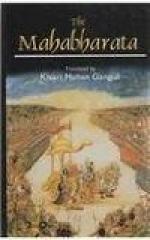376. The first line of verse 4 seems to be connected with verse 3. The second line of 4 seems to stand by itself. By connecting the first line of 4 with the second, the meaning will be—All mobile and immobile creatures that will give us away etc. Immobile creatures making gifts of kine would be utter nonsense.
377. Vallaki is the Indian lute. The Nupura is an ornament for the ankles.
378. Bhumidah is literally, a giver of land. King Saudasa, the commentator explains, was known by the name of Bhumidah in consequence of his liberality in the matter of giving away land unto the Brahmanas.
379. These are the several names by which kine are known. The first is probably derived from kine bearing the plough and thus assisting the tillage of the soil. The second implies beauty of form. The third is derived from the cow being regarded as the origin of all things in the universe: all things, therefore, are only so many forms of the cow. Viswarupa implies the same thing. Matara implies mothers, kine being regarded as the mothers of all.
380. Ghee is regarded so sacred because of its use in sacrifices. It is with the aid of ghee that the deities have become what they are. Itself sacred, it is also cleansing at the same time.
381. Sri is the goddess of Prosperity. The answer of Bhishma will explain the question fully.
382. Devendreshu is evidently a misreading for Daitendreshu.
383. The commentator explains that hence, by making gifts of gold, one comes to be regarded as making gifts of the entire universe.
384. i.e., into water, for water is identical with Agni.
385. This refers to the practice of making the sacrificial fire by rubbing two sticks of Sami. It is a very inflammable wood and is used hence in all sacred rites.
386. Hiranyaretas implies having gold for his vital seed.
387. Vasumati implies endued with wealth, so called because the seed of Agni, identified with gold, is wealth of the highest kind and fell on the Earth who from that time began to hold it.
388. Skanda is derived from Skanna or fallen out. Guha implies secret. The secrecy of his birth in the wilderness led to the bestowal of this name. He has many other names.
389. Jatarupa refers to the incident of its having assumed an excellent form after its birth from Agni.
390. The commentator explains,—Pravrittipradhanam jangamamabhut.
391. Sa guna refers to Sattwa. Tejas is identical with Buddhi, because Buddhi, like Light, discovers all things. Sattwa, again, being of the nature of space, or rather being space itself, is of universal form; that is, Sattwa is all-pervading.
392. Avasatmaka is explained by the commentator as bhranta.
393. These are different names of Brahman and Mahadeva.
394. The ‘hence’ here does not refer to what preceded immediately, but has reference to what has been said of the identity of Agni with Brahman and Rudra.




